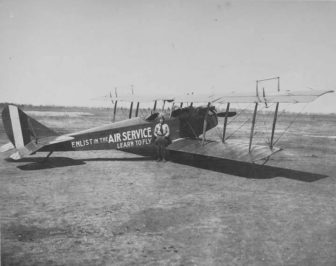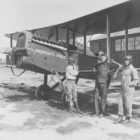Aviation Repair Depot in Montgomery Alabama
Aviation Repair Depot in Montgomery Alabama

Government post and military reservation for the repairing and manufacture of parts for airships. The United States government in the Spring of 1918 through the War Department selected Montgomery as “the ideal spot” for the location of a repair depot for what was at that time known as the Southeastern department. The government agents selected the same site, with additional land that was used by the Wright brothers in making experiments at Montgomery, with “gliders” when aviation was in its infancy.
The James Alexander Construction Company in 45 working days erected a complete repair depot with everything in readiness for the installation of machinery.
The War Department sent Major Stiles M. Decker to take command of the Depot, which was

turned over to the U. S. government on July 4. On July 21, the 882nd and 883rd repair squadrons from Kelly Field, San Antonio, Texas, arrived and found a general plan of what was to be done awaiting them. Two additional squadrons arrived on July 26th, namely, the 879th and 880th squadrons from Camp Greene, Charlotte, N. C. Although the last two squadrons were not experts, they were taken in hand by the first two arrivals and in a short time their work equaled in excellence that of their teachers. On August 7, 100 expert mechanics were received from the school for enlisted men at St. Paul, Minn. These men had been especially trained as motor mechanics, ignition and tire experts.
The first ships to be repaired came to the Depot from Gerstner Field, Lake Charles, La., and arrived while the machinery was being set up. Shortly after this time the Field was visited by a cyclone which attained a wind velocity of 96 miles an hour and did much damage to the buildings. However, under the direction of Major Decker the necessary repairs were made and the Depot was soon working with the usual rapidity that would be found in any great American industry.
Major Decker was relieved from duty on November 27, 1918, and ordered to Middleton, Pa., where he was to assume new duties at the Aviation General Supply Depot. Capt. Louis G. Hawley, commander of the 879th squadron, the ranking officer on the Field, assumed command, remaining in such capacity until December 14, when he was relieved by Major Louis R. Knight. Major Knight came to the Depot from the Armorers School at Wilbur Wright Field, Dayton, Ohio.
A number of civic and patriotic organizations cooperated with the officers at the Aviation Repair Depot in making the life of the officers and enlisted men as pleasant as possible. Among those most prominent may be mentioned the Chamber of Commerce, War Camp, Community Service, the Girls’ Patriotic League, Rotary Club, and American Red Cross. The Y. M. C. A., through its members and staff, together with the ladies who operated the Hostess House, made for the men life as near homelike as they could.
During the time that Major Knight was in command of the Field, a number of ships making cross country flights from the Pacific to the Atlantic stopped at the Field, and authorities there were informed that photographs were being taken along the routes and that from these aerial mail routes would be chosen.
Major Knight was succeeded by Major Frank E. Lackland, who pursued the same lines that had been inaugurated by Major Knight, and his work at the Field was very successful.
Upon his transfer Major W. J. Fitzmaurice took command of the Depot and is in charge of its affairs at this time.
Upon the cessation of hostilities between the United States and the Central powers the work of demobilization was handled with rapidity by the officers of the Depot. Exservice men were given the places of soldiers that had been discharged and now there is only one repair squadron at the Field, and several hundred civilian employees.
REFERENCES.—Letters and manuscript records in the Alabama State Department of Archives and History.
